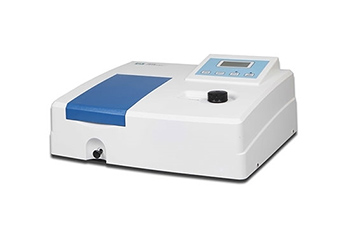What is a Spectrophotometer Used for?
Spectrophotometer, also known as spectrometer, is a scientific instrument that decomposes light with complex components into spectral lines. The measurement range generally includes the visible light region with wavelengths ranging from 380 to 780 nm and the ultraviolet region with wavelengths ranging from 200 to 380 nm. Different light sources have their own unique emission spectrum, so different luminous bodies can be used as the light source of the instrument. After the spectral light of 380-780nm wavelength emitted by the tungsten light source is refracted through a prism, a continuous chromatogram consisting of red, orange, yellow, green, blue, indigo, and violet can be obtained. These chromatograms can be used as the light source of the visible light spectrophotometer.
What is the spectrophotometer used for?
 Visible spectrophotometer
Visible spectrophotometer
Visible spectrophotometer is an instrument used to measure the absorbance of the substance to be tested to visible light (400-760nm) and performs quantitative analysis. Bacterial cell density can be measured at 600 nm.
UV VIS spectrophotometer
Ultraviolet visible spectrometer is an instrument used to measure the absorbance of the substance to be tested to visible light or ultraviolet light (200-760nm) and perform quantitative analysis. Nucleic acid and protein concentrations can be measured, as can bacterial cell density. UV VIS spectrophotometer can be divided into single beam and split beam. Their applications are different.
- Single beam: It is suitable for measuring absorbance or transmittance at a given wavelength. Generally, full-band spectral scanning cannot be performed, and high stability of the light source and detector is required. Double beam: automatic recording, fast full-band scanning. It can eliminate the influence of factors such as unstable light source and detector sensitivity change, and is especially suitable for structural analysis. The equipment is complicated and expensive.
- Split beam: The principle of split beam is that the light emitted by the same monochromator is divided into two beams, one beam directly reaches the detector, and the other beam reaches the other detector after passing through the sample. The advantage of this instrument is that it can monitor the error caused by the change of the light source, but it cannot eliminate the influence caused by the reference.
Infrared Spectrophotometer
The general infrared spectrum refers to the infrared spectrum greater than 760nm, which is the most commonly used spectral region for the study of organic compounds, and can analyze samples in various states (gas, liquid, solid). The characteristics of infrared spectrophotometer are fast, small sample amount (several micrograms to several milligrams), strong characteristics (each substance has its own specific infrared spectrum), and can analyze various states (gas, liquid, solid).
Fluorescence spectrophotometer
A fluorescence spectrophotometer is an instrument used to scan the fluorescence spectrum emitted by liquid-phase fluorescent labels. It is used in scientific research, chemical industry, medicine, biochemistry, environmental protection, clinical inspection, food inspection, teaching experiments and other fields. By measuring these parameters, not only general quantitative analysis can be done, but also the conformational changes of molecules in various environments can be inferred, thereby clarifying the relationship between molecular structure and function.
Atomic absorption spectrophotometer
Atomic absorption spectrophotometer is mainly suitable for the analysis of trace and trace components in samples. It is a powerful tool for material analysis and quality control departments to perform constant and trace metal (semi-metal) elemental analysis.
Tips for using a spectrophotometer
- The spectrophotometer should be placed in a dry room, and placed on a firm and stable workbench during use, and the indoor lighting should not be too strong. In hot weather, do not use a fan to blow air directly to the instrument to prevent the bulb filament from shining and unstable.
- Before using the spectrophotometer, the user should first understand the structure and working principle of the instrument, as well as the function of each control knob. Before pressing the power supply, the safety performance of the instrument should be checked. The power supply wiring should be firm, and the power supply should be good. The starting position of each adjustment knob should be correct, and then press the power switch.
- When the spectrophotometer is not connected to the power supply, the meter pointer must be on the "0" scale line. If this is not the case, the calibration screw on the meter can be used to adjust.

